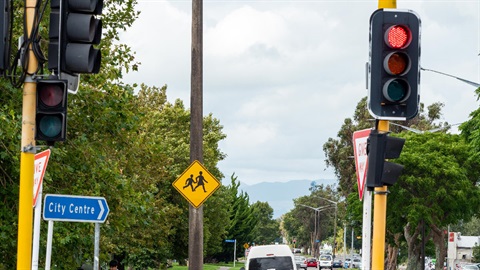Traffic signals

Learn more about traffic signals in our city and how to report any faults.
We control more than 2,000 intersections in Palmerston North, with our most busy and significant ones using traffic signals to control the flow of pedestrians, cyclists and motorists.
These cost less than roundabouts and do not take up as much space, while also making the area safer to navigate for vulnerable road users, such as pedestrians and people on bikes.
How traffic signals work
Traffic signals are controlled by a local computer. Road sensors detect vehicles as they pass and trigger the signals to change. At busy times, they may follow a set sequence.
Traffic signals on major roads, such as Rangitikei Street or Fitzherbert Avenue, serve several important functions such as managing peak flows, reducing delays and allowing vehicles in side streets to enter or cross over intersections. Signals on major roads and popular commuter routes are sequenced to allow for consistent traffic flow.
Traffic signal display times
The length of time for green traffic signals depend on traffic conditions, but they typically appear for a minimum of six seconds.
On most major roads with a speed limit up to 60 km/h, the yellow or amber light is displayed for four seconds. For higher speed roads, more time is provided for the yellow or amber traffic light.
The red-light duration depends on the size of the intersection as larger intersections require longer clearance time.
When a vehicle fails to activate a traffic signal
Some vehicles may not activate the loop to change the light sequence, such as bicycles, scooters, light motorcycles, or farming vehicles with high chassis. This happens primarily because the loop is triggered upon detecting the presence of metal in a vehicle.
The sensitivity of triggering is adjustable, but there is a balance. If the sensors are adjusted to be too sensitive, it’s possible they may detect metal from a vehicle in the adjacent lane and trigger unwanted sequences.
Reporting faults
The most common issue reported to us about traffic signals in Palmerston North is incorrect phasing or sequencing of lights. We are aware of this and we are investigating the issue.
If you think your car is not triggering the signals to change, there may be a fault with the detector. When these faults occur, the signal automatically switches from detection mode to timed mode. Timed mode may not be the best way to deal with a range of traffic volumes, but it does allow safe signal operation until the fault can be repaired. These faults are automatically detected by the computer system.
Another common problem is faulty lights or lamps; however, the computer automatically sends these fault messages to maintenance crews to repair the fault as soon as possible.
All other faults or problems with traffic signals should be reported to our Customer Service Centre at any time day or night by calling 06 356 8199.